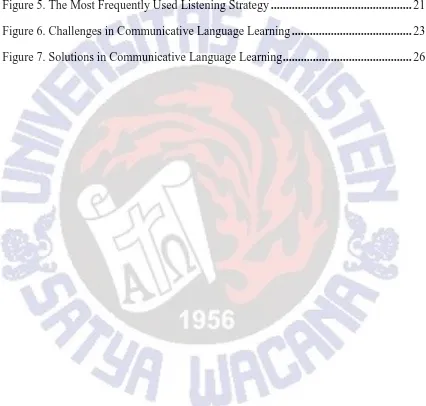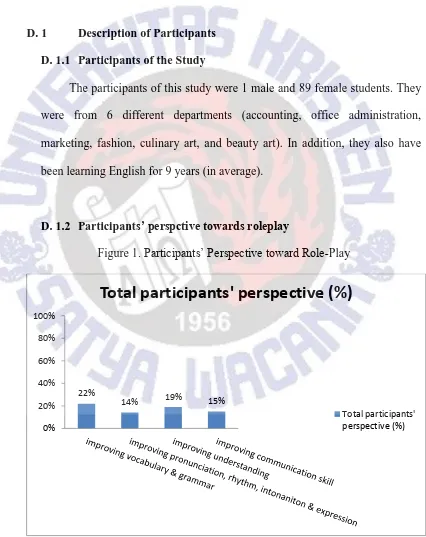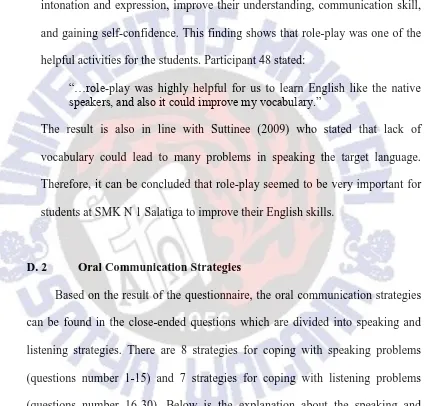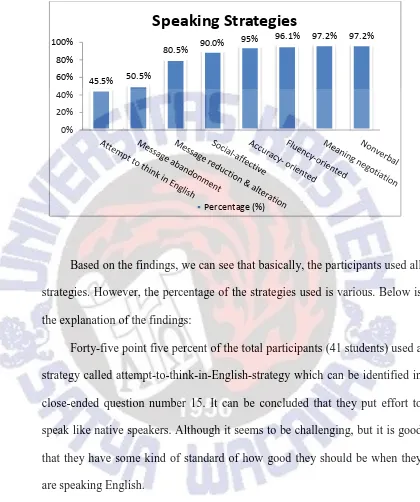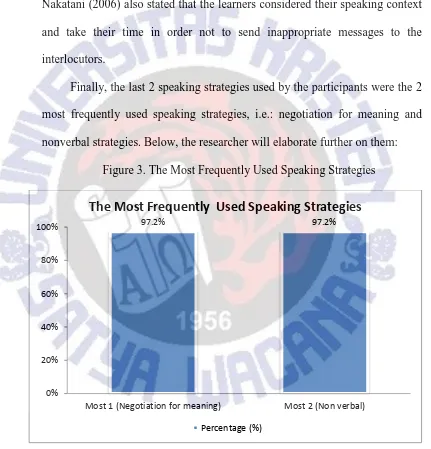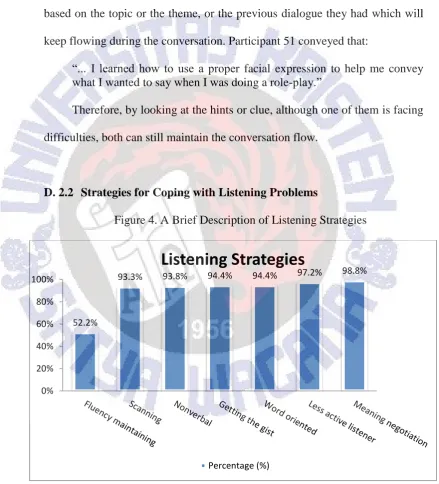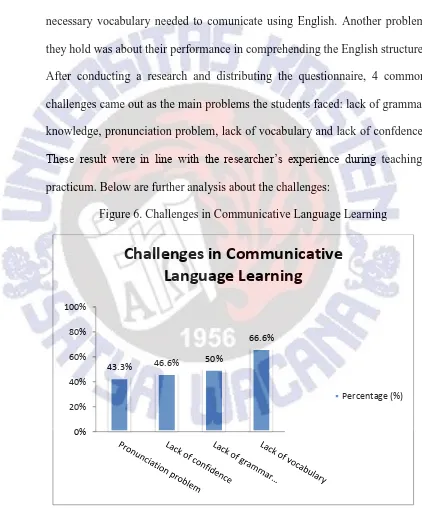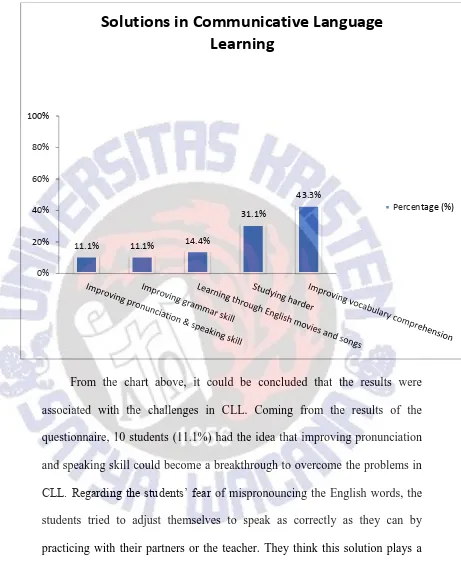i
A STUDY OF ENGLISH ORAL COMMUNICATION STRATEGIES
USED BY STUDENTS AT SMK N 1 SALATIGA
THESIS
Submitted in Partial Fulfillment
of the Requirements for the Degree of
Sarjana Pendidikan
Muhammad Isa
112013112
ENGLISH LANGUAGE EDUCATION PROGRAM
FACULTY OF LANGUAGE AND ARTS
UNIVERSITAS KRISTEN SATYA WACANA
SALATIGA
vi
COPYRIGHT STATEMENT
This thesis contains no such material as has been submitted for examination in any course or accepted for the fulfillment of any degree or diploma in any university. To the best of my knowledge and my belief, this contains no material previously published or written by any other person except where due reference is made in the text.
Copyright@ 2017. Muhammad Isa and Rindang Widiningrum, M.Hum.
vii
Table of Contents
Cover Page ... i
Pernyataan Tidak Plagiat ... ii
Pernyataan Persetujuan Akses ... iii
Publication Agreement Declaration ... iv
Approval Page ... v
Copyright Statement ... vi
Table of Content ... vii
List of Figures ... ix
A. INTRODUCTION ... 1
B. LITERATURE REVIEW ... 3
B. 1. Definition of Oral Communication Strategies ... 3
B. 2. Kinds of Oral Communication Strategies ... 4
B. 3. The Importance of Oral Communication Strategies ... 7
B. 4. Relevant Studies on Oral Communication Strategies ... 8
C. THE STUDY ... 9
C. 1. Context of The Study ... 9
C. 2. Participants ... 9
C. 3. Data Collection Instruments ... 10
C. 4. Data Collection Procedures ... 11
C. 5. Data Analysis Procedures ... 11
D. FINDINGS AND DISCUSIONS... 12
D. 1. Description of Participants ... 12
D. 1.1. Participants of The Study ... 12
viii
D. 2. Oral Communication Strategies ... 13
D. 2.1. Strategies for Coping With Speaking Problems... 14
D. 2.2. Strategies for Coping With Listening Problems ... 18
D. 3. Challenges and Solutions in Communicative Language Learning ... 22
D. 3.1. Challenges in Communicative Language Learning ... 23
D. 3.2. Solutions in Communicative language Learning ... 25
E. CONCLUSION ... 29
F. REFERENCES ... 31
G. ACKNOWLEDGMENT ... 33
ix
LIST OF FIGURES
Figure 1. Participants’ Perspective toward Role-Play ... 12
Figure 2. A Brief Description of Speaking Strategies ... 14
Figure 3. The Most Frequently Used Speaking Strategies ... 16
Figure 4. A Brief Description of Listening Strategies ... 18
Figure 5. The Most Frequently Used Listening Strategy ... 21
Figure 6. Challenges in Communicative Language Learning ... 23
1
A STUDY OF ENGLISH ORAL COMMUNICATION STRATEGIES
USED BY STUDENTS AT SMK N 1 SALATIGA
MUHAMMAD ISA 112013112
ABSTRACT
This study addressed the oral communication strategies used by students at SMK N 1 Salatiga. This study attempted to answer the research question:
‘What are the most frequently used strategies by students at SMK N 1
Salatiga to cope with speaking and listening problems during role-play
activities?’ The participants of the study were 90 students from the 11th
grade from 6 different departments. They were asked to fill in a questionnaire related to speaking and listening strategies and the challenges and solutions they used to communicate using English. Through qualitative descriptive analysis, it was noted that in speaking strategies, negotiation for meaning and nonverbal strategies showed that both had the same percentage resulting them as the two most frequently used speaking strategies. On the other hand, negotiation for meaning became the most frequently used listening strategy. The findings also implied that the most common challenge and solution the students had was associated with a lack of vocabulary and how to improve it. This study might lead to a better understanding of a better communicative language learning resulting in a more comfortable and engaging English class.
Keywords: Oral Communication Strategies, Role-Play, Communicative Language Learning
A. INTRODUCTION
2
where it could encourage the students to absorb the materials. It plays an important role in expressing emotions, ideas, and to negotiate the meaning.
According to Nakatani (2006), there had been little attention paid to examine how effective it was to use communication strategies in EFL classroom. Suttinee (2009) stated that some speakers of EFL were able to communicate effectively by only uttering some words, while others found it difficult to achieve the same level of communication.
In line with Suttinee (2009), based on the researcher’s experience of teaching students
at SMK N 1 Salatiga, the students appeared to have problems communicating in English. They tended to avoid interacting with their peers or even the teachers. They also did not have many opportunities to practice English and mostly being hesitant to speak English. Most of them ended up using their native language (Indonesian). It could be seen from the teaching and learning activities. When they were about to do role-play, the students often said “Can you repeat once again, Sir?” Here, however, it was obvious that they were actually practicing one of oral communication strategies called fluency-oriented.
A previous study about oral communication strategies (OCSs) was done by Mirzaei and Heidari (2012). One of the aims of the study was to investigate the use of OCSs between fluent and non-fluent Iranian students. The result showed that the fluent speakers more frequently used social-affective, fluency-oriented, and meaning-negotiation strategies for coping with speaking problems and used scanning and getting-the-gist strategies for coping with listening problems. The non-fluent participants, on the other hand, used more nonverbal and word-oriented strategies for coping with listening problems.
3
with others in English classroom. The findings were expected to make a more comfortable and engaging English class where the chosen strategies were applied and understood by the students. It was also believed that learners could improve communicative proficiency by developing an ability to use specific communication strategies that enable them to compensate for their target language deficiency (Bialystok, 1990; Dornyei, 1995, as cited in Nakatani, 2006). In addition, poor selection of strategies by students to accomplish language tasks could lead to unsuccessful communication (e.g. Cohen and Macaro, 2007, Rubin, 2005, Oxford et al., 2004, & Gu, 2003, as cited in Suttinee, 2009). Therefore, this study addressed the following research
question: ‘What are the most frequently used strategies by students at SMK N 1 Salatiga to cope with speaking and listening problems during role-play activities?’
B. LITERATURE REVIEW
This chapter was divided into four subheadings, i.e.: definition, kinds, and the importance of OCSs, also related studies.
B. 1 Definition of Oral Communication Strategies
4
Heideri, 2012) claimed that communication strategies were “a systematic
technique employed by a speaker to express his meaning when faced with some difficulty [difficulties]” (p.103). Therefore, we can conclude that oral communication strategies are a mean to understand one person’s intended meaning in a conversation.
According to Thornbury (2005, as cited in Mirzaei & Heideri, 2012), communication strategy (CS) was such a very useful mean for foreign language (L2) learners to be in a certain level of understanding in term of communication. In learning a language, CSs are highly important to solve problems on how to fill the communication gap between student to student, and also teacher to students. Generally, we agreed that CSs were systematic, communication-enhancing devices used to handle communication difficulties and to avoid communication breakdown (Canale, 1983; Long, 1983; Dörnyei, 1995; Nakatani, 2006, as cited in Suttinee, 2009). Oral communication strategies are seen as useful tools for learners in the process of delivering and receiving information orally in the L2.
B. 2 Kinds of Oral Communication Strategies
Nakatani (2006, as cited in Suttinee, 2009) divided CSs into 2 types: achievement and reduction. Achievement or compensatory strategies refers to a strategy where a person tried different kinds of solutions so that the communication between interlocutor kept going. Reduction or avoidance strategies refers to a strategy where a person “...gives up when the first attempt at communication fails, the former strategy being more successful for the student
[the person]”.
5
(OCSI), divided oral communication strategies (OCS) into 2 strategies covering strategies for coping with speaking and listening problems. Below is the brief description of the strategies according to Nakatani (2006, as cited in Mirzaei & Heideri, 2012):
I. Strategies for Coping with Speaking Problems
• Social-affective strategy involves learners’ affective factors in social
contexts.
• Fluency-oriented strategy is related to fluency of communication.
• Meaning-negotiation strategy while speaking is relevant to the participants’ attempts to negotiate with their interlocutors.
• Accuracy-oriented strategy is concerned with a desire to speak English accurately.
• Message-reduction-and-alteration strategy involves avoiding a communication breakdown by reducing an original message, simplifying utterances, or using similar expressions that can be confidently used.
• Nonverbal strategy while speaking requires using eye contact, gestures, or facial expressions to give hints and to help the listener guess the intended meaning.
• Message-abandonment strategy is associated with message abandonment by learners in communication.
6
II.Strategies for Coping with Listening Problems
• Meaning-negotiation strategy while listening is clearly characterized by negotiating behavior while listening.
• Fluency-maintaining strategy involves paying attention to the fluency of conversational flow.
• Scanning strategy includes focusing on specific points of speech, such as
subject and verb, the interrogative, and the first part of the speaker’s
utterance, in which important information is usually contained.
• Getting-the-gist strategy requires paying attention to general information contained in speech rather than to specific utterances and considering the
context and the speaker’s previous sentences to guess overall meaning.
• Nonverbal strategy while listening is related to making use of nonverbal
information, such as speaker’s eye contact, facial expression, and gestures.
• Less-active-listener strategy represents negative attitudes towards using active listening strategies for interaction. Students who utilize this strategy translate the message into their native language little by little and depend heavily on familiar words.
• Word-oriented strategy reflects a learner’s tendency to capture the meaning
7
B. 3 The Importance of Oral Communication Strategies
Oral communication strategies play an important role in conversation. For L2 users, they may encounter many difficulties during the conversation. For example, they might struggle to communicate their intended meaning, so that the things that they wanted to say often switched into simple words they could utter or even communicate in their mother tongue (Ervin, 1979, as cited in Jamshidnejad, 2011).
Strategies helped the users to keep the conversation going. According to Coupland, et al (1991, as cited in Jamshidnejad, 2011), CSs are used to solve
many problems such as ‘breakdowns’ and ‘gaps’ in communication. For example,
when a person chose to give up when they cannot find the appropriate words in English, he/she chooses not to continue the conversation. This may lead to hurt the other interlocutor for not being a good or balanced partner in the conversation due to the gaps in linguistic knowledge.
Many scholars (e.g. Faerch & Kasper, 1983, 1986, Tarone & Yule, 1989, Willems, 1987, Donyei & Thurrell, 1991, 1994, as cited in Jamshidnejad, 2011) also believed that the use of specific communication strategies enabled the
speakers to ease the L2’s deficiencies that it would improve their communicative proficiency. Appropriate strategies help the conversation kept going so that their proficiency in English as EFL increased although it might seem to run slowly. Rababah (2003, as cited in Jamshidnejad, 2011) also added that appropriate CSs
could lead “...to learning by eliciting unknown language items either from an
interlocutor (the appeal for help strategy) or from their own language knowledge
through paraphrasing or circumlocution” (p.530). In short, appropriate strategies
8
B. 4 Relevant Studies on Oral Communication Strategies
There have been some relevant studies about oral communication strategies. The two of them are Nakatani (2006) and Suttinee (2009). Nakatani (2009) studied on how valid information about learner perception of strategy use during communicative tasks could be gathered systematically from English as a foreign language (EFL) learners. He attempted to develop a questionnaire for statistical analysis, named the Oral Communication Strategy Inventory (OCSI). The result of this study included 8 categories of strategies for coping with speaking problems and 7 categories for coping with listening problems during communication. To validate the use of his instrument, his participant reports on the Strategy Inventory for Language Learning (SILL) were compared with the result of the OCSI. When combined with the oral test scores. The result revealed that students with high oral proficiency tended to use specific strategies, such as social affective strategy, fluency-oriented strategy, and negotiation of meaning.
On the other hand, Suttinee (2009) studied Thai students’ OCSs,
9
assistance in developing risk-taking techniques such as social-affective, fluency-oriented, help seeking, and circumlocution strategies.
C. THE STUDY
This study addressed the most frequent oral communication strategies used by students at SMKN 1 Salatiga. It was done in the qualitative-descriptive manner as the
researcher examined a research question: ‘What are the most frequently used strategies
used by students at SMKN 1 Salatiga to cope with speaking and listening problems during role-play activities?’
C. 1 Context of the Study
This study was done at SMKN 1 Salatiga where the researcher had done his teaching practicum. The location of the context is in Salatiga, Central Java, Indonesia. It is a vocational school which has 6 departments covering accounting, office administration, marketing, fashion, culinary art, and beauty art. They study English with various chapters based on their departments according to their context. Doing role-play is one of the most frequent tasks. For example, the material is about procedural text, then in the accounting department, the students will do a role-play about how to make a financial report, while in the culinary art department, the students will do a role-play about how to make pizza.
C. 2 Participants
10
exam) and the freshmen (who only had 1-year experience in the school). A sample of convenience method was also used as the selection of the participants.
C. 3 Data Collection Instruments
The researcher used only one instrument: a questionnaire. There were several reasons why the researcher chose questionnaire. First, besides it was practical and could be collected from a large number of people in a short period of time and in a relatively cost effective way, distributing questionnaire could limit affect to its validity and reliability. Second, it could be analyzed with rich and elaborated details. Third, it also helped the researcher to ensure that the responses were detail and accurate.
The study used mixed-type questionnaire. The questionnaire of this study consisted of 30 close-ended and 2 open-ended questions. The researcher changed a number of original questions done by Nakatani (2006) from 58 into 30 points. It
was done to fit the participants’ context which was meant for high school students. Therefore, the questionnaire used to collect data for this research had been adapted and translated into Indonesian in order to make the participants understand the points easily. Two simple open-ended questions were also designed to gain more information about how to role-play helped them to develop their English skills and how they actually managed to resolve their difficulties. Therefore, the researcher might collect clearer explanation from the participants. The participants recorded the responses of each statement in close-ended part
based on a degree of frequency (‘strongly agree’, ‘agree’, ‘disagree’, ‘strongly
disagree’). The researcher also piloted the questionnaire to 23 participants which
11
questionnaire was distributed to all 90 participants without including the pilot participants.
C. 4 Data Collection Procedures
Firstly, the researcher looked for 90 participants by approaching the participants after they attended the English class and asking for their approval to help the researcher to complete the questionnaire. This was done in order to get the target participants of the research. It was done to 6 different classes from 6 departments so that the researcher could get more than 90 questionnaire and carefully check 90 questionnaires which were thoroughly completed. The participants were openly informed about the purpose of the study, and they were all willing to take part. They were then asked to give honest answers, as the researcher guaranteed them anonymity. The questionnaire was then collected, recapped, and analyzed in qualitative-descriptive manner.
C. 5 Data Analysis Procedures
12 D. FINDINGS AND DISCUSSION
After obtaining the data, the researcher managed to combine the keywords in the data to 3 subheadings, i.e.: the description of the participants, oral communication strategies and challenges and solutions in communicative language learning. Below are the details of the findings and discussion:
D. 1 Description of Participants D. 1.1 Participants of the Study
The participants of this study were 1 male and 89 female students. They were from 6 different departments (accounting, office administration, marketing, fashion, culinary art, and beauty art). In addition, they also have been learning English for 9 years (in average).
D. 1.2 Participants’ perspctive towards roleplay
Figure 1. Participants’ Perspective toward Role-Play
22%
14% 19% 15%
0% 20% 40% 60% 80% 100%
Total participants' perspective (%)
13
Figure 1 shows the result of the open-ended question number 1. Most of the participants had positive perspective towards role-playing. There were approximately 20 students (22% of the total participants) indicated that role-play could improve their vocabulary and grammar skill. While many also thought that role-play had a vital role to improve their pronunciation, rhythm, intonation and expression, improve their understanding, communication skill, and gaining self-confidence. This finding shows that role-play was one of the helpful activities for the students. Participant 48 stated:
“…role-play was highly helpful for us to learn English like the native
speakers, and also it could improve my vocabulary.”
The result is also in line with Suttinee (2009) who stated that lack of vocabulary could lead to many problems in speaking the target language. Therefore, it can be concluded that role-play seemed to be very important for students at SMK N 1 Salatiga to improve their English skills.
D. 2 Oral Communication Strategies
14
D. 2.1 Strategies for Coping with Speaking Problems
Figure 2. A Brief Description of Speaking Strategies
Based on the findings, we can see that basically, the participants used all strategies. However, the percentage of the strategies used is various. Below is the explanation of the findings:
Forty-five point five percent of the total participants (41 students) used a strategy called attempt-to-think-in-English-strategy which can be identified in close-ended question number 15. It can be concluded that they put effort to speak like native speakers. Although it seems to be challenging, but it is good that they have some kind of standard of how good they should be when they are speaking English.
Fifty point five percent of the participants or 46 students used a message-abandonment strategy which can be identified in close-ended questions number 13 and 14. The participants often gave up when they could not deliver what they wanted to say. They faced such troubles that they decided not to tell their intention to the interlocutors. Some also left the conversation unfinished.
15
Message-reduction-and-alteration strategy was used by 80.5% of the participants (73 students) which can be identified in close-ended questions number 9 and 10. They used simple and familiar utterances to express their intention although what they really meant was not completely delivered. They even changed the real meaning of what they actually intended because they had troubles in delivering what they wanted to say. Although they also realized that it was far from their goal.
As many as 81 participants (90%) used social-affective strategy which can be identified in close-ended questions number 1 and 2. Vandergrift (2003) suggested that the strategy would ease their problems because it was
concerned with the learners’ interaction with other speakers and attitude towards learning. They did not mind to make mistakes and that they enjoyed the conversation. The learners also controlled their anxiety to interact with the interlocutors.
Ninety-five percent of the participants or 86 students were concerned to use accuracy oriented strategy which can be identified in close-ended questions number 7 and 8. They seem to have a high desire to speak English accurately. They even paid attention to their grammar and word order. They also corrected their mistakes by themselves when they were speaking consciously. Dörnyei and Scott (1997, as cited in Jamshidnejad, 2011) stated
that they were ‘repairing’ themselves which was really good. For example like
“No, he don’t... he doesn’t know” or “I cannot put myself in their... in those
16
The Fluency-oriented strategy was used by 96.1% of the participants (87 students) which can be identified in close-ended questions number 3 and 4. In this strategy, the learners paid attention to the elements of speaking such as the rhythm, intonation, pronunciation when they were speaking. They also did not mind repeating what they wanted to say until the interlocutor understood. Nakatani (2006) also stated that the learners considered their speaking context and take their time in order not to send inappropriate messages to the interlocutors.
Finally, the last 2 speaking strategies used by the participants were the 2 most frequently used speaking strategies, i.e.: negotiation for meaning and nonverbal strategies. Below, the researcher will elaborate further on them:
Figure 3. The Most Frequently Used Speaking Strategies
The diagram above shows an interesting fact that both negotiation-for-meaning strategy and the nonverbal strategy have the same percentage as much as 97.2%. This makes them become the 2 most frequently used speaking strategies. Ervin (1979, as cited in Jamshidnejad, 2011) earlier stated that the
97.2% 97.2%
Most 1 (Negotiation for meaning) Most 2 (Non verbal)
The Most Frequently Used Speaking Strategies
17
struggle a learner faced in speaking was commonly caused by the lack of linguistic ability to communicate what they wanted to say. Therefore, their intention may often be modified into something they could say. This strategy called negotiation for meaning can be identified in close-ended questions number 5 and 6. Meaning-negotiation strategy was surprisingly used by 97.2% of the total participants (88 students), according to Rababah (2003), could be considered as a communication strategy which led the user to learn to paraphrase what they meant into something they could say. According to Nakatani (2006), this strategy was also considered as an important skill to improve their L2 ability according to SLA (Second Language Acquisition) researchers (such as Nakahama, Tyler, &Lier, 2001 and Pica, 1996). The benefit of this strategy is that the conversation can keep flowing. This is also the gist of communication strategies that they should be used to overcome breakdown, gaps, or problems in communication. Participant 15 revealed that:
“When I was doing a role-play, I felt like the activity helped me a lot. It
was because I have a lack of vocabulary.”
Thus, it led her to face difficulties delivering her intention by only mentioning words she knew. At that moment, she applied the negotiation for meaning strategy. Actually, in this strategy, the learners give example and ask
others’ help to maintain the flow of the conversation. Both interlocutor and speaker need to cooperate to avoid communication breakdown (Nakatani, 2006).
18
eye contact in order to attract the attention of the listener. However, in nonverbal strategy, there are many possible ways to use. For example using gestures and facial expressions. These ‘actions’ are used to give hints or clue to the listener to help them guess what they wanted to say. When 2 persons are speaking, basically they can understand what the other person are going to say based on the topic or the theme, or the previous dialogue they had which will keep flowing during the conversation. Participant 51 conveyed that:
“... I learned how to use a proper facial expression to help me convey what I wanted to say when I was doing a role-play.”
Therefore, by looking at the hints or clue, although one of them is facing difficulties, both can still maintain the conversation flow.
D. 2.2 Strategies for Coping with Listening Problems
Figure 4. A Brief Description of Listening Strategies
Based on the findings, we can see that the participants used many strategies to help the participants facing problems in listening to English.
52.2%
93.3% 93.8% 94.4% 94.4% 97.2% 98.8%
0% 20% 40% 60% 80% 100%
Listening Strategies
19
Almost all of the strategies are equally used by them. There are many reasons behind these. Below we will look deeper about the explanation of the findings:
Forty-seven participants (52.2%) used fluency-maintaining strategy to overcome their problems in listening to English which can be identified in close-ended questions number 19 and 20. This strategy lets the learners pay more attention to every detail on the conversation. This strategy aims to keep the conversation flow. They also pay more attention to the pronunciation, rhythm, and the intonation of the interlocutor. These are down in order to ease them getting the intended messages. For them, their ability to comprehend the conversation did really matter. This is important because they can show how well they understand the conversation. Rost and Ross (1991, as cited in Nakatani, 2006) also supported that such strategies would help the learners to keep the interactions going to achieve the communication goal.
The next listening strategy used was scanning strategy which was chosen by 84 participants (93.3%) which can be identified in close-ended questions number 21, 22, and 23. It helped the participants to get clues about the intended messages the speakers were about to tell. The participants paid more attention to the emphasized words, the beginning of the sentence(s), and subjects and verbs used. By doing such strategy, they will get the important information. After understanding the clues, they could prepare for what they were going to say (Nakatani, 2006).
20
eye contact, and facial expression to response difficult words or other problems in understanding the interlocutor during the conversation. This is the simplest strategy a learner could do to keep the conversation going and maintaining the interaction.
The data obtained shows that 85 students or 94.4% of the total participants liked to use getting-the-gist-strategy which is found in close-ended
questions number 24 and 25. The students guessed the interlocutors’ messages
based on what they had said previously. They also tried to understand the important points of the conversation. According to Nakatani (2006), they preferred to pay attention to the general information rather than the specific ones. Most of the participants are beginner learners of English as Foreign Language (EFL), so it will be hard for them to understand every single detail of the utterance. Their background information will help them to comprehend the messages.
The next listening strategy employed was the word-oriented strategy which was done by 85 students (94.4% of the total participants) which can be observed in close-ended question number 30. By applying the strategy, the participants are required to understand every word used by the interlocutor(s) in order to respond the utterance(s). Based on the open-ended question number 1, most of the participants claimed that memorizing words could help them in comprehending the messages when they were in conversation.
21
the learners to understand the meaning by restating the English words into Indonesian during the conversation. Beginner level students of EFL often use this strategy because beginners tended to be more passive in the interaction using English. Nakatani (2006) claimed that this strategy could lead to
negative attitude because the learners’ improvement would be slow.
Finally, the last listening strategy used by the participants was the most frequently used listening strategies, i.e.: negotiation for meaning. Below, the researcher will explain further about them:
Figure 5. The Most Frequently Used Listening Strategy
From the data above, it can be viewed that there were 89 participants (98.8% of the total participants) who chose negotiation for meaning strategy. It can be identified in close-ended question number 16, 17, and 18. Poulisse and Schils (1989, as cited in maid, 2014) confirmed that English as Foreign Language could be mastered by the learners who understood how to use communication strategies. In this strategy, the learners modify their interaction
98.8%
0% 20% 40% 60% 80% 100%
Negotiation for meaning
The Most Frequently Used Listening Strategy
22
with the speaker to keep the conversation flow. For example, they ask the interlocutor to slow down the speed, to use easy and understandable words, and to ask for clarification when they faced problems. These are done in order
to understand the speakers’ intended messages and avoid misunderstandings. It is strengthened by Participant 8 who demonstrated that English learners could produce some new vocabulary during role-playing and they asked its interpretation in order to improve their ability in listening. It makes this strategy as one of the helpful strategies needed to be done by the learners because it can help them to make use of the opportunities to practice their English.
D. 3 Challenges and Solutions in Communicative Language Learning
23
D. 3.1. Challenges in Communicative Language Learning
The researcher had previously experienced being a student-teacher doing
teaching practicum at SMK N 1 Salatiga. From the researcher’s sight, it
appeared that the students tended to have many problems in learning English, mainly in speaking and listening skills. Mostly, they seemed to be lack of the necessary vocabulary needed to comunicate using English. Another problem they hold was about their performance in comprehending the English structure. After conducting a research and distributing the questionnaire, 4 common challenges came out as the main problems the students faced: lack of grammar knowledge, pronunciation problem, lack of vocabulary and lack of confdence.
These result were in line with the researcher’s experience during teaching-practicum. Below are further analysis about the challenges:
Figure 6. Challenges in Communicative Language Learning
Based on the chart above, we can see that the percentage of each category is such a convincing proof that they did have problems from various
24
perspectives. The first problem they faced was about pronunciation. As many as 39 participants (43.3%) conveyed that pronunciation was one of the most difficult parts of learning English. They may be confused as there are certain vocals or consonants pronounced differently in English. Based on the
researcher’s experience of teaching role-play to the students, the students seemed to be difficult to figure out how to pronounce a word that they became afraid of mispronouncing the words. The teacher’s help turned out to discourage them. It was complicated.
The next challenge the participants faced is that they seem to feel less confident in using L2. As many as 42 students or 46.6% of the total participants felt that using English to communicate with their partners or interlocutors was a moment which needed extra courage because they were about to use L2. They are not familiar in producing words or utterances other than those from their mother tongue. A belief about English users should be competence and correct in using that target language has controlled their mind. A fear of making mistakes makes them not to be sure using English in CLL. Therefore, many students must be encouraged by the teacher to make them at least feel confident in using English.
There were 50% of them or 45 participants admitted that there was a lack of grammar knowledge that made them difficult to interact using English. They probably have difficulties in constructing their intended meaning from their mother tongue (Indonesian) to English where there were obviously many differences in structure and other language elements.
25
agreed that remembering English vocabulary might be confusing and difficult. This problem may lead to another problem they have which actually they literally translate English words into Indonesian without adjusting it. This problem also resulting in the speaking difficulty where they cannot convey their intention in English and prefer to be silent or speaking using Indonesian. According to Hasan (2016), vocabulary deficiency had become one of the most significant evidence that learners experienced difficulties that they needed new words to assist them speaking up. He added that consequently, their skills (reading, listening, writing and speaking) would not be good enough.
D. 3.2. Solutions in Communicative Language Learning
26
Figure 7. Solutions in Communicative Language Learning
From the chart above, it could be concluded that the results were associated with the challenges in CLL. Coming from the results of the questionnaire, 10 students (11.1%) had the idea that improving pronunciation and speaking skill could become a breakthrough to overcome the problems in
CLL. Regarding the students’ fear of mispronouncing the English words, the students tried to adjust themselves to speak as correctly as they can by practicing with their partners or the teacher. They think this solution plays a vital role in the interaction. It will make the interlocutors understood the utterances better.
From the chart above, as many as 10 participants (11.1%) realized that improving grammar skill was necessary. Even though it was a few number of
11.1% 11.1% 14.4%
31.1%
43.3%
0% 20% 40% 60% 80% 100%
Solutions in Communicative Language
Learning
27
the total participants who answered that idea, it represented that the students had to care about how vital the grammar in language learning. By understanding the grammar structure and paying attention to the differences in the structure and other language elements, they do not need to worry about constructing the intended meaning from their mother tongue (Indonesian) to English.
The next solution revealed from the participants’ perspective is learning through English movies and songs. Thirteen participants (14.4%) believed that learning through English movies and songs might assist them in their English skills, especially speaking and listening skills. They attempted to learn how to pronounce correctly, construct the words appropriately and understand the intended meaning by doing this idea. This solution seemed to be the most fun activity because they were unconsciously learning while watching or singing.
The other solution about studying harder is generally the most common and applicable one from almost all learning aspects. A number of 28 participants (31.1 %) perceived that this idea could be the solution in CLL. It cannot be denied that the successful of learning L2 depended on how hard the learners wanted to improve their skills.
28
many they possibly can, it would improve their ability in English interaction. They realized it was important to grasp the vocabulary as a guidance in learning L2. The fact seen by the researcher as a student teacher was the students took notes the new words from the dictionaries and learned from it.
29
into several groups to create English poems, songs, or mini drama to perform in the class.
E.
CONCLUSION
The goal of this study was to answer the research question: ‘What are the most
frequently used strategies by students at SMK N 1 Salatiga to cope with speaking and listening problems during role-play activities?’ After collecting the data, the researcher found out that to cope with speaking problems, there were two most frequently used speaking strategies which had the same result percentage (meaning-negotiation and nonverbal strategies). On the other hand, to cope with listening problems, meaning-negotiation strategy became the most frequently used listening strategy.
The findings did not only show the most strategies used to cope with speaking and listening problems but also there were challenges and solutions which appeared to be the reasons why they applied such strategies in the English class. The challenges were various, but dealing with vocabulary was the most common one. The result also showed that mostly the participants put more effort on how to improve their vocabulary.
The result of this study was expected to give benefit for the English teachers. Some participants stated that the classes were boring, difficult, and confusing. The teachers can create a more engaging class by also considering their anxieties and strategies to overcome the problem of learning English as a foreign language as the students were still at the beginner level.
30
Yet, the researcher managed to meet them in person and ask them to fill in the questionnaire. It also turned out that some questionnaire did not provide enough and clear response as requested. Therefore, the researcher distributed the questionnaire to more than the required amount of the total participants to get enough data and then categorize the responses into several big groups to make the findings clearer.
31
REFERENCES
Alqahtani, M. (2015). The importance of vocabulary in language learning and how to be taught. International Journal of Teaching and Education, 3(3), 21-34.
Cameron, L. (2001). Teaching languages to young learners. Cambridge: Cambridge University Press.
Hasan, L. (2016). The effect of lack of vocabulary on English language learners’ performance with reference to English departments students at Salahaddin University-Erbil. Iraq: Salahaddin University-Erbil.
Hmaid, Y. (2014). The impact of teaching oral communication strategies on English language learners in Libya. De Montfort University Leicester. Retrieved from: https//www.dora.dmu.ac.uk/bitstream/handle/2086/10947/The%20one%20correct ed%2022%20dec%20master%20doc%20final%202.pdf?sequence=1&isAllowed =y
Mirzaei, A., & Heideri, H. (2012). Exploring the use of oral communication strategies by (non) fluent L2 speakers. The journal of Asia TEFL, 9(3), 131-156.
Nakatani, Y. (2006). Developing an oral communication strategy inventory. The Modern Language Journal 90, 151-168.
Jamshidnejad, A. (2011). Developing accuracy by using oral communication strategies in EFL interactions. Journal of Language Teaching and Research, 2(3), 530-536.
Keyton, J. (2001). Instructor’s manual for communication research: Asking questions,
finding answers. Mountain View, CA: Mayfield.
32
Rababah, G. (2003). Communication problems facing Arab learners of English: A personal perspective. TEFL Web Journal, 2(1). Retrieved from www.jllonline.co.uk/journal/jllearn/3_1/rababah.pdf
Sayyedeh, E. H., Shahrzad, S., & Fatemeh, B. (2015). Exploring the use of oral communication strategies by Iranian EFL critical thinkers. International Journal of Language, Literature and Culture. 2(2), 6-12.
Suttinee, C., Kanchana, P. (2009). A study of English communication strategies of Thai university students. MANUSYA: Journal of Humanities, 17, 100-126.
Thornbury, S. (2005). How to teach speaking. Harlow, England: Longman.
Ting, S. H., & Lau, L. Y. (2008). Lexical and discourse-based communication strategies ofMalaysian ESL learners. Malaysian Journal of ELT Research, 4, 18-31.
33
ACKNOWLEDGEMENTS
34
APPENDIX
Kepada yang terhormat partisipan kuesioner,
Nama saya Muhammad Isa, mahasiswa Fakultas Bahasa & Seni, Universitas Kristen Satya Wacana. Saya sedang melakukan penelitian untuk skripsi tentang strategi komunikasi lisan dalam bahasa Inggris yang digunakan oleh murid-murid di SMKN 1 Salatiga. Saya mohon bantuan Anda untuk menjawab pertanyaan dibawah ini dengan jujur. Respon Anda akan dirahasiakan dan tidak akan mempengaruhi nilai Anda. Terima kasih.
Informasi Demografis
Jenis Kelamin : Laki-laki / Perempuan (lingkari salah satu) Kelas / Jurusan : .../...
Belajar bahasa Inggris selama : ... tahun
Pernyataan-pernyataan berikut mendeskripsikan strategi yang Anda gunakan dalam berkomunikasi secara lisan dalam bahasa Inggris. Bacalah setiap pernyataan dengan baik, berilah tanda ( √ ) pada kolom yang sesuai denganjawaban Anda!
NO. PERNYATAAN SANGAT
Saya tidak berkeberatan berbicara dalam
bahasa Inggris meskipun membuat
kesalahan.
2.
Saya menikmati percakapan dalam bahasa Inggris meskipun terkadang merasa cemas untuk berinteraksi.
3.
Saya memperhatikan cara pengucapan, ritme, dan intonasi saya dalam menggunakan bahasa Inggris.
4. Saya mengulangi apa yang ingin saya
katakan sampai lawan bicara mengerti.
5. Saya memberikan contoh apabila lawan
bicara tidak mengerti apa yang saya katakan.
6.
Saya meminta bantuan orang lain ketika tutur
bahasa saya kurang tepat dalam
berkomunikasi.
7. Saya memperhatikan tata bahasa dan urutan
kata dalam berkomunikasi.
8. Saya mengoreksi diri saya sendiri ketika saya
35 9.
Saya menggunakan kata/ kalimat sederhana yang lazim digunakan meskipun makna percakapan berkurang.
10.
Saya mengganti makna asli dari suatu kalimat karena tidak mampu menyampaikan makna aslinya.
11.
Saya mencoba melakukan kontak mata
dengan lawan bicara ketika sedang
berkomunikasi.
12.
Saya menggunakan bahasa tubuh dan
ekspresi wajah apabila tidak mampu
menyampaikan maksud perkataan saya.
13.
Saya sering tidak menyampaikan maksud perkataan saya keseluruhan karena merasa kesulitan.
14. Saya menyerah ketika saya tidak mengerti
apa yang ingin saya katakan.
15. Saya mencoba berbicara layaknya penutur
asli bahasa Inggris.
16.
Saya meminta lawan bicara untuk berbicara perlahan apabila saya tidak mengerti apa
mengulangi perkataanya atau meminta
klarifikasi ketika saya sulit memahaminya.
19. Saya merasa tidak perlu memahami setiap
detil percakapan.
20. Saya memperhatikan cara pengucapan, ritme,
dan intonasi lawan bicara.
21. Saya memperhatikan lawan bicara dalam
penekanan kata.
22.
Saya memperhatikan setiap permulaan
kalimat yang dituturkan dan menebak maksud perkataan lawan bicara.
23.
Saya memperhatikan subjek dan kata kerja dari suatu kalimat yang dituturkan oleh lawan bicara.
24.
36
Bacalah pertanyaan dibawah ini dengan seksama dan tulis jawaban Anda di tempat yang tersedia!
1. Menurut Anda, apakah kegiatan role-play (mini drama/ berdialog memainkan peran menggunakan
bahasa Inggris) berperan dalam meningkatkan kemampuan bahasa Inggris Anda? Jelaskan! ☺
...
...
2. Masalah/ kesulitan apa yang sering Anda hadapi ketika berinteraksi menggunakan bahasa Inggris
di kelas? (Anda dapat memilih lebih dari 1 jawaban dengan memberikan tanda centang [√]) Kurang pengetahuan tentang penggunaan tata
bahasa.
Kesulitan dalam pengucapan.
Hanya menguasai sedikit kosa kata. Kurang percaya diri.
Lainnya: . . .
Jelaskan pilihan Anda dan berilah contoh penyelesaian/ solusi dari kesulitan anda tersebut! ☺
...
...
Jika saya membutuhkan informasi lebih lanjut terhadap jawaban/respon Anda terhadap kuesioner ini, bersediakah Anda untuk saya wawancara?
YA / TIDAK (lingkari salah satu)
Jika YA, isilah informasi dibawah ini dengan lengkap:
Nama :
Ketika mendengarkan, saya memperhatikan kontak mata, ekspresi wajah, dan bahasa tubuh lawan bicara.
28.
Saya menebak maksud perkataan lawan bicara dengan memperhatikan kata/ kalimat lazim yang digunakan.
29.
Saya mencoba menerjemahkan kedalam bahasa Indonesia secara bertahap untuk memahami maksud perkataan lawan bicara.
30. Saya mencoba memahami setiap kata yang
